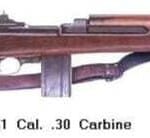
Introduction
The M1917 Enfield is one of the most significant and underappreciated rifles in American military history. Serving as the primary service rifle for the American Expeditionary Forces (AEF) in World War I, this robust and reliable bolt-action rifle was a product of industrial ingenuity and wartime necessity. Built upon the foundation of the British Pattern 1914 (P14) rifle, the M1917 became the most widely used American rifle in the Great War and continued serving in various roles for decades afterward.
Origins: The British Pattern 1914 and Its Influence
The story of the M1917 begins with the British Pattern 1914 rifle (P14). In the early 20th century, the British Army sought to modernize its infantry rifle, developing a new design intended to replace the Short Magazine Lee-Enfield (SMLE). Initially chambered in the experimental .276 Enfield cartridge, the rifle was designed as a Mauser-style bolt-action weapon, offering greater accuracy and long-range capability than the SMLE.
However, with the outbreak of World War I, Britain abandoned the .276 Enfield cartridge and instead adopted the rifle in .303 British to maintain ammunition compatibility with existing stocks. British arms factories, overwhelmed with production demands for war matériel, turned to the United States for manufacturing assistance.
Three American companies—Winchester, Remington, and Eddystone (a Remington subsidiary)—were contracted to mass-produce the P14. These firms retooled their facilities and delivered thousands of rifles to the British government. The P14 performed admirably in British service, especially as a sniper rifle, due to its exceptional accuracy.
The Birth of the M1917: America’s Answer to Wartime Shortages
When the United States entered World War I in April 1917, the M1903 Springfield rifle was the standard-issue service rifle of the U.S. military. However, production capacity at Springfield Armory and Rock Island Arsenal was insufficient to meet the urgent demand for rifles. To rapidly arm American troops, the government turned to the P14’s manufacturers with an urgent request: modify the P14 to fire the U.S. standard .30-06 Springfield cartridge.
The result was the M1917 Enfield, a slightly modified version of the P14. Key changes included:
- Rechambering for .30-06 Springfield to align with U.S. ammunition logistics.
- Adjustments to the bolt face and magazine to accommodate the different cartridge dimensions.
- Modified sights and markings to meet U.S. military standards.
Despite these changes, the M1917 retained the P14’s robust receiver and its Mauser-style controlled-feed bolt-action system, making it one of the strongest bolt-action service rifles ever fielded.
Mass Production and Industrial Might
The production of the M1917 was a triumph of American industrial power. Over 2,193,429 rifles were manufactured between 1917 and 1918, broken down as follows:
- Eddystone Arsenal (Remington subsidiary): 1,181,908 rifles
- Remington: 545,541 rifles
- Winchester: 465,980 rifles
Eddystone produced the largest share, thanks to its massive factory in Pennsylvania, which operated at peak efficiency during the war. Winchester’s early production suffered from dimensional inconsistencies, leading to interchangeability issues, though these were later corrected.
By the time American troops entered combat in significant numbers, the M1917 had outnumbered the M1903 Springfield on the front lines, with approximately three out of every four U.S. soldiers carrying an M1917 in battle.
Battlefield Performance: A Soldier’s Perspective
The M1917 quickly gained a reputation for accuracy, reliability, and ruggedness. Its 26-inch barrel provided a longer sight radius than the M1903, enhancing precision. The aperture rear sight was also superior for quick target acquisition compared to the M1903’s open-notch sight.
While soldiers praised its durability, some found its weight and length cumbersome. At 9.2 lbs (unloaded), it was heavier than the M1903 (8.7 lbs) and the British SMLE (8.8 lbs). Additionally, the M1917 featured a cock-on-closing bolt, which some American troops—used to the M1903’s cock-on-opening action—found awkward at first.
Nevertheless, the rifle’s five-round internal magazine, coupled with the power of the .30-06 Springfield cartridge, made it an effective weapon in the trenches of the Western Front.
The .30-06 Springfield Cartridge and Its Lethality
The M1917 was chambered in .30-06 Springfield, the U.S. military’s standard cartridge since 1906. Known for its exceptional long-range ballistics and stopping power, the .30-06 performed superbly in combat. Key specifications included:
- M1906 Ball: 150-grain FMJ bullet at 2,700 fps
- M1 Ball (WWII-era): 174-grain FMJ boat-tail at 2,640 fps
- M2 Ball: 152-grain FMJ at 2,800 fps
The M1917’s strong action allowed it to safely fire these powerful rounds, making it one of the most durable bolt-action rifles of its time.
Comparisons with Contemporary Rifles
During World War I, the M1917 faced off against some of the most legendary rifles of the era:
- German Gewehr 98 (8mm Mauser): A strong, accurate rifle, but its open sights were less effective for rapid target engagement.
- British SMLE (.303 British): Faster cycling with a ten-round magazine, but its shorter sight radius made long-range shooting less precise.
- U.S. M1903 Springfield (.30-06): Lighter and more compact but produced in smaller numbers and lacked the M1917’s aperture sights.
Post-War Service and Legacy
Following World War I, the M1917 was gradually phased out as the M1903 regained prominence. However, it saw service again in World War II, primarily issued to reserve units, training battalions, and allied forces under the Lend-Lease Act.
Large numbers of M1917 rifles were sent to China, the Philippines, and the Netherlands to aid in anti-Japanese resistance. Some M1917s were even used in the Korean War and by indigenous forces in the early Vietnam War.
On the civilian side, surplus M1917 rifles were sold to the public, with many being sporterized into hunting rifles due to their strong actions and excellent accuracy.
Conclusion: The M1917’s Place in Military History
The M1917 Enfield is an often-overlooked but critically important rifle in U.S. military history. As America’s most widely used rifle in World War I, it proved that industrial innovation and adaptability could overcome wartime shortages.
Its accuracy, reliability, and rugged construction made it a formidable weapon, and its legacy endures through its continued use in conflicts beyond World War I. While the M1903 Springfield and M1 Garand often receive more historical recognition, the M1917 deserves its place as one of the greatest bolt-action service rifles ever made.
Discussion groups on these rifles can be found here.
If you know of any forums or sites that should be referenced on this listing, please let us know here.




